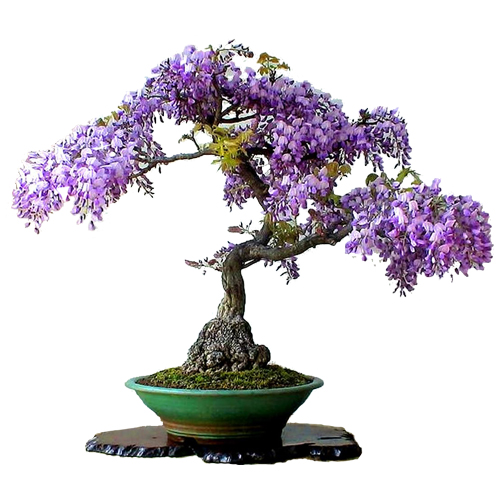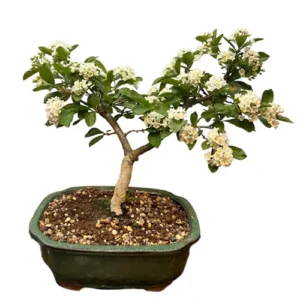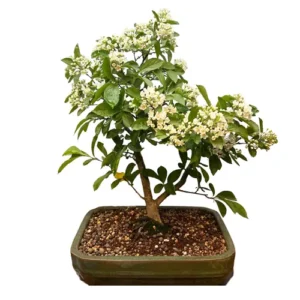Wisteria Floribunda
Wisteria Bonsai
Wisterias are famous for their abundant cascading flowers that vary from blue or lilac to white or pink. They are fast growing, strong climbers and full of character once aged. They are not very difficult to keep alive but getting them to flower can be a little trickier. Wisteria floribunda is native to Japan while Wisteria sisensis comes from China and has shorter, stronger smelling flowers.

Wisteria Bonsai Care Tips
Placement
The wisteria needs to be placed outside in a warm, sunny position. The sunlight is essential to its flowering and the more sun you can provide, the better.
These are a very hardy species and there is no need to worry about frost when planted in the ground but when planted in a container it is best to protect it from the coldest temperatures. Bringing it in to a cold greenhouse, cold frame or unheated conservatory would be suitable protection for winter.
Watering
There is no definitive guide to watering, and it should be conducted on an observational schedule, not a routine. This means that it is important to keep an eye on the moisture levels of the soil to avoid over and under watering, both which can lead to dropping leaves and/or root death. The amount of water a bonsai requires depends on pot size, climate, airflow, soil and tree type so it is best to use your eyes and fingers to assess whether the soil is damp, wet or dry.
If the top inch or so of soil has dried, it is ready to be watered. When you water, ensure an even coverage over the roots and soil, allowing water to flow out from the bottom of the pot to ensure a good soaking.
If you are a first-time bonsai owner, another way to water is by submerging the entire pot in water until the bubbles stop. If you choose this method, be aware that your bonsai may not need watering for another two to four days, but this will depend on the factors mentioned above such as soil type, pot size and climate.
The wisteria requires a huge amount of water during the summer, especially when they are flowering. You can water as generously as you like without much risk of overdoing it. Some recommend standing the pot in water but you should not leave it there for a very long time as this will risk the roots rotting. If you choose to stand the pot in water, do so for 3-4 hours maximum on very hot days.
Feeding & Fertilising
Using fertiliser on your wisteria will help encourage healthy growth and this should be done periodically from once a week to every two months and only during the growing season. You can start adding Chrysal Liquid Bonsai Feed to your water from March until October and use weekly. Use Naruko Fertiliser Slow Release Bonsai Feed once every one to two months. With Buddhist Pine trees, less is more, and we tend to advise using half the recommended dosage to see how your Buddhist Pine reacts first.
It is better to feed the wisteria with a low nitrogen fertiliser in order to discourage a lot of fast leaf growth and encourage flowers. Use a low nitrogen feed in late summer until early autumn.
Pruning & Wiring
Reduce new shoots to two or three sets of leaves a couple of times throughout the year and cut back branches that are too long in late summer. Do not pinch out a wisteria because this will result in extra straggling shoots that don’t produce flowers. Avoid pruning in early spring or after later summer because this will remove the potential flower buds. If you don’t want to collect seeds, remove the seed pods once they appear because they weaken the tree. After flowering, cut it back hard and remove about half of the flower-bearing stubs. Allow the wisteria to grow freely after this but cut back the long shoots and tendrils to two or three buds once they become too long, as mentioned before.
You can also thin out the wisteria canopy when it gets a little dense in summer and the inner twigs and leaves begin to suffer.
Wisteria is best shaped through pruning and they do not require wiring.
Repotting
Repotting your tree is an important way to provide a fresh and suitable soil mix and ensure appropriate root health. Repot in early spring. Generally, your wisteria will need to be re-potted once every two years if it is young, while older ones can stay in their pots for longer. However, you should always check if it has become root-bound before you change pots. You can do this by lifting the tree gently out of the pot by the main trunk and examining the root system. You will know it is ready if you can see that the roots are circling around each other and the pot. If, however, they still appear contained in the soil, you should place it back and wait until the following spring to check again.
Trees that are ready for repotting will require root pruning, a suitable new pot and appropriate soil mix.
When repotting, do not cut back the root mass by a large amount, and choose a well-draining soil mix that has a neutral or slightly higher PH value of 5-6 but not over 7. We tend to use a mixture of different speciality bonsai soils on our trees. Every species is different so please contact us for free soil-mix advice or to take advantage of our repotting service.
Bonsai trees aren’t only magnificent additions to an indoor oasis, they are more than capable of standing out in any garden. Many Bonsai species are incredibly hardy and withstand nature’s colder and damper turns with aplomb making them worthwhile outdoor plants. We have an extensive library of care guides for outdoor bonsai trees. It’s not about selecting the perfect bonsai, it’s about selecting the perfect bonsai for you.
Wisteria Bonsai - Typical Queries
How to identify a Wisteria Bonsai?
You can identify a Wisteria Bonsai by its distinctive features, such as its twisted trunk, its dark green compound leaves, and its fragrant flower racemes. Wisteria Bonsai come in different varieties, such as Chinese Wisteria, Japanese Wisteria, and American Wisteria, which have different flower colours and shapes.
How to propagate a Wisteria Bonsai?
There are several methods to propagate a Wisteria Bonsai, such as seeds, cuttings, layering, and grafting. Seeds are the easiest way to propagate a Wisteria Bonsai, but they may not produce the same flower colour or quality as the parent plant. Cuttings are a more reliable way to propagate a Wisteria Bonsai, but they need to be taken from healthy and mature plants. Layering is a technique that involves bending a branch to the ground and covering it with soil until it develops roots. Grafting is a method that involves attaching a scion (a piece of stem with buds) to a rootstock (a plant with roots) of the same or a compatible species.





















